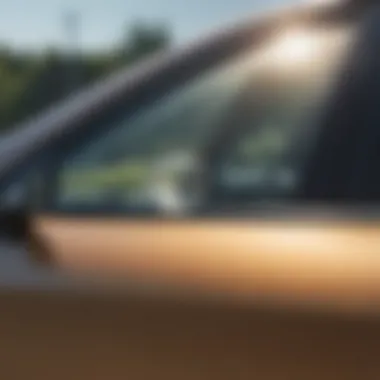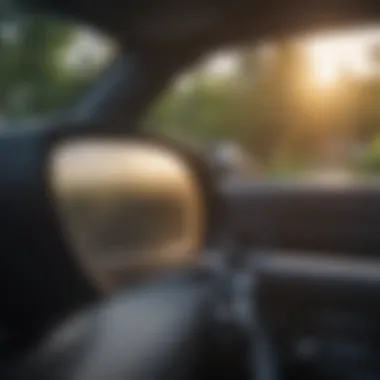Exploring the Advantages of Car Windshield Sun Film


Intro
Car windshield sun film often appears as a simple accessory for vehicles. However, the underlying benefits and implications can be profound. Choosing the right sun film is essential for maintaining a pleasant driving environment and ensuring the durability of a vehicle. This discussion dives into various facets of sun film, highlighting its relevance in today's automotive landscape.
Composition of Car Windshield Sun Film
Understanding what sun film is made of can aid in evaluating its effectiveness. Typically, barrier films are made from a blend of polyester, adhesive, and ultraviolet (UV) protective materials. Specific formulations provide unique benefits, such as heat resistance or glare reduction. This composition plays a crucial role in how well the film performs, affecting the comfort during driving.
Benefits of Car Windshield Sun Film
The advantages of applying sun film extend beyond aesthetic purposes. Here are several key benefits that deserve attention:
- Temperature Control: Sun film provides substantial sun heat reduction. This results in a noticeable difference in comfortable cabin temperature, particularly in hot climates.
- UV Radiation Reduction: A major benefit is the blocking of harmful UV rays, which helps in protecting both passengers and the car interior.
- Glare Reduction: Sun films can significantly minimize glare. This is especially useful in bright conditions. It benefits the driver's vision, enhancing overall safety.
- Privacy and Security: Tinted films can offer a degree of privacy. Additionally, they may deter theft by obscuring the view of any belongings inside the car.
Understanding Car Windshield Sun Film
Car windshield sun film has become an essential consideration for vehicle owners and car enthusiasts alike. This article explores its significance fully, detailing how it extends beyond mere aesthetics to encompass comfort, safety, and vehicle longevity. In understanding car windshield sun film, both its benefits and implications come to the forefront, unlocking a comprehensive perspective on this crucial automotive accessory.
Definition and Purpose
Car windshield sun film, commonly known as window tint, refers to a thin laminate film applied to the interior surface of the windshield. Its primary purpose is to reduce the amount of heat entering the vehicle and to protect occupants from harmful ultraviolet emissions. Moreover, sun film assists in glare reduction, providing a comfortable driving environment and preserving the integrity of the interior components. In essence, it embodies a fusion of functionality and comfort, catering to the rising preferences of modern drivers seeking enhanced in-car experiences.
Composition of Sun Film
Exploring the composition of sun film sheds light on its efficacy and versatility. The construction of sun films typically involves several elements: polyester base layers, adhesives, and various metallic or tinting agents that govern light transmission and reflectivity. The resulting structure is engineered to endure high temperatures and protect the film quality across years of use.
- Polyester Layers: These form the backbone of window films. Their durability contributes to the longevity of the installation.
- Adhesives: These ensure that the film remains firmly in place, resisting bubbling or peeling.
- Tinting Agents: Such materials may include dyes or metals, which control how much light enters and how much solar energy is absorbed or reflected.
Understanding these components is critical. It provides consumers with insight into the varying performance levels of the different films available, thus shaping informed choices in their applications and vehicle safety measures.
Benefits of Using Sun Film on Windshields
Car windshield sun film carries multiple benefits that directly impact comfort, safety, and aesthetics for drivers and passengers. Utilizing sun film not only addresses practical needs but also aligns with preferences for visual appeal and personal privacy. Understanding these benefits is crucial for potential users considering the installation of such films for their vehicles. Below are the key points outlining the advantages of using sun film on windshields.
Heat Reduction and Comfort
Heat reduction is one of the most tangible benefits of sun film. These films are designed to absorb and block significant amounts of solar energy. By decreasing the amount of heat that enters the vehicle, sun films help maintain a more comfortable climate inside. Individuals can benefit particularly in extreme weather, where steps to reduce cabin temperature significantly enhance driving comfort. Shifting away from reliance merely on air conditioning not only promotes comfort but can also lead to less fuel consumption, making this a wise choice for environmentally conscious drivers.
UV Ray Protection
Protection against UV radiation is another important reason to consider sun film. Many sun films are specialized to filter out up to 99% of harmful UV rays. Prolonged exposure to these rays can lead to skin damage and increase the risk of skin cancer. Inside a vehicle, the front seats and dashboard can also degrade due to UV exposure. Therefore, applying sun film on windshields acts as a simple yet effective barrier against such harmful effects. This benefit reinforces the necessity of long-term health and preservation of vehicle interiors for any user.
Glare Reduction
Glare from sunlight and headlights at night results in unsafe driving conditions. Sun film aids in reducing this glare, simplifying the driving experience in bright conditions and at night. By minimizing distractions from bright lights, sun film enables clarity for drivers, both enhancing safety and overall enjoyment behind the wheel. The reduction in glare stands as a rather straightforward advantage, often overlooked yet essential for maximizing driving safety. A driver can concentrate better with diminished glare.
Increased Privacy and Security
Increased privacy is, for many, one of the most appealing attributes of windshield sun film. Tinted windows obstruct views into the car, thereby providing security for both personal belongings and the passengers. An added layer of privacy protects sensitive items left inside the vehicle during the day. Moreover, it can make car interiors less inviting for would-be thieves. In a world where safety is important, the right choice of sun film enhances a sense of security for vehicle owners.
Aesthetic Enhancements
Another benefit of car windshield sun film is the aesthetic improvement it brings to vehicles. Sun films come in various shades and qualities, allowing car owners to choose how their vehicle communicates style and sophistication. Customized shades may enhance the overall look, often making older vehicles feel newer. This aesthetic dimension provides drivers with a chance to express individuality and visually enhance their vehicles simply and effectively.


Integrating a sun film that provides practical benefits alongside visual appeal can transform a typical driving experience into something premium.
By weighing these benefits thoughtfully, car owners can make informed decisions regarding sun film options tailored to meet their specific needs and preferences.
Types of Windshield Sun Films
The use of different types of car windshield sun films can greatly influence the overall effectiveness in reducing heat, glare, and UV penetration. Understanding the variations allows consumers to make informed decisions tailored to their specific needs. Not only does it affect comfort and safety, but the right choice can also enhance the aesthetic appearance of the vehicle. Here, we will delve into four primary categories of sun films that car owners can consider when looking to apply this protection.
Dyed Films
Dyed films involve a process where dyes are applied to the film to create the desired tint. These films are largely preferred for their cost-effectiveness while still providing some insulation and UV protection. The application usually results in a darker appearance of the glass, offering privacy and reducing glare from the sun. However, dyed films may fade over time, which is an essential consideration for long-term use.
Some notable features of dyed films include:
- Heat Rejection: Moderate performance in heat rejection.
- UV Protection: Blocks harmful UV rays to some extent.
- Fade Resistance: Vulnerable to wear and could fade over repeated sun exposure.
Metalized Films
Metalized films incorporate tiny metal particles within the film itself. This type of film has shown a significant capability for reflecting heat away from the vehicle. In addition to providing effective heat reduction, metalized films also offer increased durability compared to dyed counterparts. One drawback is the potential for signal interference; using electronic devices in the vehicle could be affected by these films.
Key aspects of metalized films include:
- Heat Reflectivity: Excellent at becoming a barrier against warmth.
- Durability: More robust than dyed films, providing longer usage.
- Signal Interference: Could tamper with radio and GPS signals.
Ceramic Films
Ceramic films employ advanced technology, using ceramic materials that grant both durability and heat rejection without interfering with electronic signals. They are widely recognized for their superior performance while allowing drivers to benefit from excellent visibility. One main benefit of ceramic films is their long lifespan, ensuring lasting protection and aesthetic appeal.
Attributes associated with ceramic films are:
- High Heat Resistance: Superior ability to deflect heat.
- UV Block: Provides maximum UV ray protection.
- Clarity: Maintains clear visibility without any distortion.
Composite Films
Composite films merge materials and technologies from previous types to create an all-around efficient option. These films typically blend organic materials, metal layers, and ceramic particles, producing a comprehensive solution for temperature regulation, glare reduction, and UV exposure. While composite films can be more expensive, they often provide a balanced combination of all desired features.
Advantages of composite films include:
- Versatility: Good heat rejection, UV protection, and glare management.
- Longevity: Extended lifespan due to multi-layered technology.
- Performance Flexibility: Suitable for a range of conditions and preferences overall.
As each of these types presents distinct advantages, the choice largely depends on consumer needs, such as budget, aesthetic preferences, and performance expectations. It's advisable to evaluate replacement costs when selecting any sun film based on its specific features and long-term effectiveness.
Understanding the different types of windshield sun films enhances decision-making, leading to improved comfort levels and safety for drivers and passengers alike.
Legal Considerations for Installing Sun Film
Installing car windshield sun film not only enhances comfort and protects interior components but also comes with legal implications. It's critical for vehicle owners to be aware of these factors before proceeding with installation. Different regions enforce various laws and guidelines regarding the use of sun films, aimed to ensure safety and compliance on the roads. Therefore, adhering to these regulations is key for responsible ownership and usage.
State Regulations
State regulations concerning sun film installation vary significantly across the U.S. or other countries. Each state can dictate which type of film is acceptable, as well as how much visible light counselors have to pass through the windshield. Generally, many states do allow sun films but impose specific limitations such as:
- Front Windshield Usage: Many states require that any tint for the front windshield is only installed above the manufacturer's AS-1 line.
- Windows Behind the Driver's Seat: While some states allow dark tinting here, others regulate it strictly. For instance, heavily tinted windows can lead to issues during inspections.
- Medical Exceptions: Certain states may provide exemptions for individuals with medical conditions requiring additional protection from sunlight.
Keeping informed about local regulations helps to avoid unnecessary complications or penalties.


Visible Light Transmission Standards
Visible Light Transmission (VLT) standards are a critical aspect to consider when selecting sun films. These standards primarily evaluate how much light can pass through the windshields with installed film.
Typical VLT standards include:
- Windshield: Minimum allowed VLT can range from 70-80% in many regions, though some allow film as low as 25%.
- Other Windows: The allowable VLT value generally decreases for windows behind the driver.
Understanding VLT standards is vital for selecting compliant products and avoiding issues regarding traffic enforcement.
Penalties for Non-Compliance
Failing to comply with the established laws for sun film can lead to several repercussions. Non-compliance can carry significant penalties, including:
- Fines: Many states enforce monetary penalties that vary by offense severity. Repeated offenses often have escalating costs.
- Mandatory Removal: State authorities may require the immediate removal of non-compliant films at the owner's expense.
- Insurance Consequences: Driving a car registered as non-compliant can complicate liability coverage or lead to denial during the claim process.
Staying informed of and compliant with local laws regarding sun film installations contributes to safer driving while safeguarding investment.
Incorporating car windshield sun film benefits but keeping in mind these legal considerations ensures that one avoids pitfalls tied to color or reflectivity limits and reinforces responsible vehicle enchancements.
Application Process of Sun Film
The installation of car windshield sun film is a significant process that involves several phases. Each phase not only impacts the film's effectiveness but also ensures durability and maintains the aesthetic appeal of the vehicle. A correct application can drastically enhance the benefits such as heat reduction, UV protection, and glare reduction. This section outlines the three main stages of sun film application: preparation steps, installation techniques, and curing and maintenance period.
Preparation Steps
Before the actual installation of sun film, proper preparation is crucial. This step includes the following important actions:
- Cleaning the Windshield: A thorough cleaning of the windshield is essential. Use a glass cleaner and soft cloth to remove dirt and greasy residues. Cleaner glass prevents any imperfections during installation.
- Choosing the Right Film: It’s important to select the correct type of sun film based on personal requirements and environmental conditions. Factors such as heat reduction, UV protection levels, and visual appearance should be considered.
- Collecting Tools and Materials: Gather all necessary tools beforehand. Common items include a utility knife, application squeegee, solution spray, and heat gun for shaping the film. Incomplete tools can disrupt the process and affect the film's outcome.
Correct preparation sets a solid foundation for the entire installation process. Ignoring any preparatory steps could lead to suboptimal performance of the windshield sun film.
Installation Techniques
The installation of sun film requires precision and care. Several techniques can ensure a successful application:
- Water Application Method: Many prefer using a soap-and-water solution on the glass for installation. This helps in sliding the film into position during the application.
- Heat Activation: After placing the film correctly, a heat gun can be utilized to enhance adhesion. Carefully warming the film allows it to settle better into corners and curves, promoting a tight fit.
- Squeegeeing: Once in place, use a squeegee to remove excess water and air bubbles. Ensuring there are no pockets underneath the film is critical for long-term adherence.
These techniques are essential to achieve a professional look and functionality of the installed film. Addressing every detail with the proper installation techniques can significantly enhance the performance expected from the sun film.
Curing and Maintenance Period
After completing the installation, a curing period is needed. Curing allows the adhesive to bond firmly to the glass.
- Curing Time: Typically, this period can last anywhere from a few days to a week. During this time, it’s recommended to avoid rolling down the windows to maintain proper positioning.
- Initial Maintenance: Directly after installation, you must be cautious with the new film. It’s ideal to avoid cleaning the film for at least a week. When it’s time to clean, use a solution that is safe for tinted windows, avoiding ammonia-based products.
- Long-term Care: Continuous care helps in extending the life of the film. Gentle cleaning practices and careful maintenance of hardware around windows ensure the longevity of the installed film. Regular examination for any peeling or bubbling can preempt bigger issues.
Following these guidelines ensures the film acts as intended and preserves both its functionality and aesthetic appeal over time.
"The success of the sun film application lies in attention to details. Don’t rush, and ensure to follow each step carefully for best results."
Maintenance of Sun Film
Maintaining car windshield sun film is essential for ensuring its continued performance and appearance. Many car owners may underestimate the impact of proper maintenance, thinking that once the film is applied, the job is done. However, neglecting care can lead to diminished effectiveness of the film over time. Understanding how to care for sun film can enhance its benefits, prolong its lifespan, and maintain the aesthetics of the vehicle.
Cleaning Recommendations


Regular cleaning of sun film is vital to preserve both visibility and functionality. Using the right materials and techniques ensures that the film does not scratch or become damaged. Here are some key recommendations:
- Avoid using abrasive cleaners or tools. This can scratch the film surface.
- Instead, opt for a mild soap solution mixed with water for regular cleaning.
- Use a soft cloth or microfiber towel to gently wipe the surface. This helps to avoid any damage.
- Clean the film in shaded areas to prevent soap or water spots from forming on a hot surface.
Furthermore, it is advisable to avoid ammonia-based products. These can degrade the film over time. Regular cleaning can prevent buildup of dirt that clouds the view, enhancing driver comfort and safety.
Longevity and Durability
The longevity and durability of sun film heavily depend on factors like the quality of the film used and the manner in which the film is maintained. High-quality films typically come with warranties that can extend up to a lifetime, indicating their durability. Here are a few considerations regarding longevity:
- Quality Materials: Using well-reviewed brands like 3M and Llumar usually assures that you are getting reliable, long-lasting sun film.
- Environmental Exposure: Extended exposure to harsh weather could potentially damage low-quality films. Proper installation and regular maintenance help minimize wear and tear from environmental factors.
- Sensitivity to moisture: Be particularly aware of films experiencing constant dampness. Each time you wash your car, check that all water is properly dried, as this can lead to bubbling or lifting over time.
- Preventative Care: Employing proper maintenance techniques enhances the lifespan. For example, using non-abrasive tools for cleaning can significantly reduce scratches and maintain clarity over years.
In summary, proper maintenance directly correlates with the performance and lifespan of windshield sun film. If cleaned carefully and maintained well, drivers can expect their sun film to last for years while delivering the maximum benefits it offers.
Key point: Properly maintaing windshield sun film enhances effectiveness and extends its durability.
Cost Analysis of Sun Film Installation
Analyzing the cost of sun film installation on car windshields is essential in understanding the financial commitment involved. This topic not only influences buying decisions but also helps to clarify the long-term benefits versus initial expenses. A thorough understanding of costs related to sun film helps consumers make informed choices.
Factors Influencing Cost
Several factors affect the cost associated with sun film installation. These elements must be careful considered to avoid unexpected expenses later on.
- Type of Film: The specific kind of sun film chosen is a major contributor to overall cost. Dyed films are usually less expensive, while ceramic and composite films tend to be on the higher end of the price spectrum.
- Installation Service: Professional installation often includes labor fees that can vary significantly based on location and the expertise of the technician. DIY options can reduce costs but increase risks associated with incorrect application.
- Vehicle Type: The model of the vehicle can influence pricing. More complex designs and larger windshields may demand higher installation fees due to the additional work needed.
- Local Regulations: Compliance with state laws sometimes adds to the cost. Specific films that meet legal requirements may also carry a premium price.
With these factors analyzed, potential buyers can gain a clearer picture of how much they may expect to invest in sun film installation.
Long-term Value Assessment
The long-term value of sun film installation extends beyond just the initial costs. Assessing this value is key for buyers.
- Energy Savings: One significant advantage is the reduction in air conditioning costs. Effective sun films can limit heat, thus saving energy.
- Increased Comfort: Over time, passengers will benefit from a cooler interior. Extreme heat can lead to discomfort and even possible heat-related health concerns during summer months.
The economic and health benefits can outweigh the initial investment, making sun film a promoter of comfort and safer driving conditions.
- Extended Lifespan of Interior: The sun's UV rays can cause damage to dashboards and upholstery. By reducing exposure, sun film can help maintain the vehicle’s interior, improving longevity and ultimately retaining resale value.
- Insurance Benefits: Some car insurance policies may provide discounts for vehicles equipped with protective sun film. Confirming with your insurer could provide additional significant savings over the years.
Industry Trends and Innovations
In the realm of automotive enhancements, industry trends and innovations are pivotal. Car windshield sun films have evolved significantly, driven by consumer demand for better comfort, safety, and vehicle performance. New materials and technologies enable higher UV protection and lower heat absorption. Such innovations not only meet aesthetic desires but contribute profoundly to the overall car experience.
With advancements in manufacturing processes and product design, automotive enthusiasts have more options than before. In this section, emerging technologies and sustainability trends will be explored.
Emerging Technologies in Sun Films
Recent years have brought forth several groundbreaking technologies in the realm of sun films. One prominent development is the use of nanotechnology in film composition. This advancement enhances transparency while improving heat rejection properties. Nano-ceramic films, for instance, significantly reduce infrared rays, providing a cooler cabin while still allowing clarity of vision.
Moreover, innovative layering techniques are in demand. Modern films often employ multiple layers, combining dyes, polymers, and metals to strike a balance between performance and visibility. These films not only resist scratches and fading over time, but also promote thermal insulation, which can extend the life of vehicle interiors.
Another key advancement has been the rise of smart films. These films can adjust tint based on sunlight intensity, optimizing clarity and glare reduction automatically. Such features are increasingly attractive for high-end vehicle models, since they offer a tailored experience for the users. The synchronization with navigation and climate systems highlights a tailored approach to passenger comfort.
The pivot towards more advanced technologies illustrates significant strides towards not only aesthetic considerations, but also practical enhancements that hold lasting impacts on comfort, safety, and efficacy.
Sustainability in Manufacturing
Sustainability is no longer just a buzzword; it has become a core principle driving the production of car windshield sun films. The automotive industry is increasingly aware of its role in environmental conservation. Many manufacturers are focusing on eco-friendly materials in their sun film products. This includes using substrates made from recycled materials as well as involving sustainable sourcing methods.
Additionally, techniques such as low-emission production methods are becoming the norm rather than the exception. This change not only reduces the carbon output but also promotes a more responsible life cycle for the products. Packaging materials are also evolving, with many companies opting for biodegradable or recyclable options.
A move towards sustainability translates to a direct impact on consumers. As drivers become more environmentally conscious, they prefer to invest in products from companies that prioritize ecological considerations. It positions brands favorably when competing in the market thus intensifying the push toward sustainable innovations.



